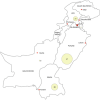Exploring eye care pathways, patient priorities and economics in Pakistan: A scoping review and expert consultation study with thematic analysis
- PMID: 35318687
- PMCID: PMC9310639
- DOI: 10.1111/opo.12977
Exploring eye care pathways, patient priorities and economics in Pakistan: A scoping review and expert consultation study with thematic analysis
Abstract
Purpose: As the prevalence of eye diseases increases, demand for effective, accessible and equitable eye care grows worldwide. This is especially true in lower and middle-income countries, which have variable levels of infrastructure and economic resources to meet this increased demand. In the present study we aimed to review the literature on eye care in Pakistan comprehensively, with a particular focus on eye care pathways, patient priorities and economics.
Methods: A systematic scoping review was performed to identify literature relating to eye care in Pakistan. Searches of relevant electronic databases and grey literature were carried out. The results were analysed through a mixed methods approach encompassing descriptive numerical summary and thematic analysis. To consolidate results and define priority areas for future study, expert consultation exercises with key stakeholders were conducted using qualitative semi-structured interviews.
Results: One hundred and thirty-two papers (published and unpublished) were included in the final review. The majority (n = 93) of studies utilised a quantitative design. Seven interlinked themes were identified: eye care pathways, burden of eye disease, public views on eye-related issues, workforce, barriers to uptake of eye care services, quality of eye care services and economic impact of blindness. Research priorities included investigating the eye care workforce, the quality and efficiency of current eye care services, eye care services available in rural Pakistan and the costs and benefits related to eye care provision and sustaining eye care programmes.
Conclusions: To the best of our knowledge, this is the first review to synthesise evidence from papers across the field relating to eye care in Pakistan. As such, this work provides new insights into the achievements of the national eye health programme, challenges in eye care in Pakistan and priority areas for future research.
Keywords: Pakistan; blindness; eye care services; scoping review; thematic analysis; visual impairment.
© 2022 The Authors. Ophthalmic and Physiological Optics published by John Wiley & Sons Ltd on behalf of College of Optometrists.
Conflict of interest statement
The authors report no conflicts of interest and have no proprietary interest in any of the materials mentioned in this article. A version of the abstract has been published online in Ophthalmic and Physiological Optics in the article ‘British Congress of Optometry and Vision Science 2021 Abstracts.’
Figures









Similar articles
-
Beyond the black stump: rapid reviews of health research issues affecting regional, rural and remote Australia.Med J Aust. 2020 Dec;213 Suppl 11:S3-S32.e1. doi: 10.5694/mja2.50881. Med J Aust. 2020. PMID: 33314144
-
Eye donation from palliative and hospice care contexts: the EDiPPPP mixed-methods study.Health Soc Care Deliv Res. 2023 Nov;11(20):1-159. doi: 10.3310/KJWA6741. Health Soc Care Deliv Res. 2023. PMID: 37929829
-
The future of Cochrane Neonatal.Early Hum Dev. 2020 Nov;150:105191. doi: 10.1016/j.earlhumdev.2020.105191. Epub 2020 Sep 12. Early Hum Dev. 2020. PMID: 33036834
-
Public sector reforms and their impact on the level of corruption: A systematic review.Campbell Syst Rev. 2021 May 24;17(2):e1173. doi: 10.1002/cl2.1173. eCollection 2021 Jun. Campbell Syst Rev. 2021. PMID: 37131927 Free PMC article. Review.
-
Strategies used for childhood chronic functional constipation: the SUCCESS evidence synthesis.Health Technol Assess. 2024 Jan;28(5):1-266. doi: 10.3310/PLTR9622. Health Technol Assess. 2024. PMID: 38343084 Free PMC article.
Cited by
-
Trends and drivers of blindness and vision loss burden attributable to age-related macular degeneration from 1990 to 2021: findings from the Global Burden of Disease Study 2021.BMJ Open. 2025 Jul 22;15(7):e094953. doi: 10.1136/bmjopen-2024-094953. BMJ Open. 2025. PMID: 40701607 Free PMC article.
-
Quality of refractive error care in Pakistan: an unannounced standardised patient study.BMJ Open Ophthalmol. 2023 Oct;8(1):e001354. doi: 10.1136/bmjophth-2023-001354. BMJ Open Ophthalmol. 2023. PMID: 37879750 Free PMC article.
-
Barriers to accessing eye care in Pakistan: a mixed methods study.Prim Health Care Res Dev. 2025 Jul 15;26:e58. doi: 10.1017/S1463423625100261. Prim Health Care Res Dev. 2025. PMID: 40660665 Free PMC article.
References
-
- World Health Organisation . Towards universal eye health: a global action plan 2014–2019, Geneva, 2013. Available from: https://www.who.int/blindness/actionplan/en/. Accessed 24 Apr 2021.
-
- World Health Organisation . World report on vision. Switzerland. 2019. Available from: https://www.who.int/publications/i/item/9789241516570. Accessed 12 May 2021.
-
- United Nations . World population prospects 2019, Volume II: demographic profiles. Available from: https://population.un.org/wpp/Graphs/1_DemographicProfiles/Pakistan.pdf. Accessed 10 Apr 2021.
Publication types
MeSH terms
LinkOut - more resources
Full Text Sources
Research Materials

